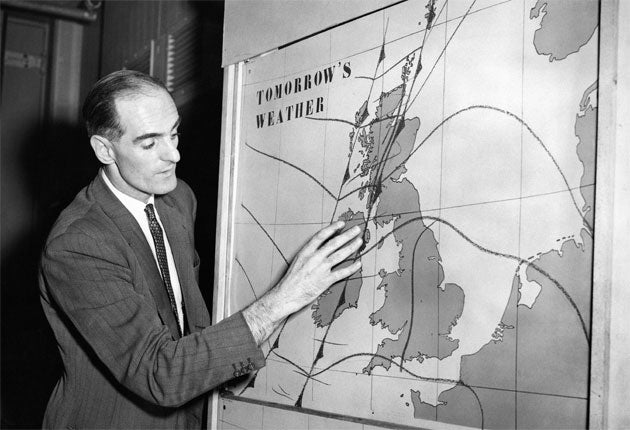George Cowling: Britain's first television weatherman

Your support helps us to tell the story
From reproductive rights to climate change to Big Tech, The Independent is on the ground when the story is developing. Whether it's investigating the financials of Elon Musk's pro-Trump PAC or producing our latest documentary, 'The A Word', which shines a light on the American women fighting for reproductive rights, we know how important it is to parse out the facts from the messaging.
At such a critical moment in US history, we need reporters on the ground. Your donation allows us to keep sending journalists to speak to both sides of the story.
The Independent is trusted by Americans across the entire political spectrum. And unlike many other quality news outlets, we choose not to lock Americans out of our reporting and analysis with paywalls. We believe quality journalism should be available to everyone, paid for by those who can afford it.
Your support makes all the difference.Before magnetic clouds, satellite technology, hi-tech graphics and colour television brought more pizzazz to forecasts on screen, a 32-year-old Yorkshireman who worked for the Meteorological Office became the BBC's first on-screen weather presenter. George Cowling stepped in front of the camera at 7.55pm on 11 January 1954. Even though he delivered the forecast in a traditional, BBC style, long before weather presenters adopted a more chatty, informal manner, Cowling was able to turn the scientific explanations into human reality by telling viewers that high winds would make the following day a good one for hanging out washing.
Located in a small corner of the BBC's Lime Grove announcer's studio, he used two hand-drawn charts pinned to a blackboard - showing the weather for "today" and "tomorrow" - and had a pair of dividers for measuring isobar spacing to give wind speeds. "We used charcoal sticks to demonstrate wind directions, rain areas etc on the maps and the charcoal dust covered our sweaty hands and clothes," Cowling recalled of his experience in a studio that became intensely hot because of the amount of lighting needed for the cameras. He also established a tradition for ending the forecasts, explaining: "I said what everyone else says - 'That's it from me.'"
This presentation, in those days of black and white television, replaced the BBC's previous practice of showing a weather chart on screen accompanied by captions, which had been introduced daily in 1949. The new, four-and-a-half-minute format also began the day's programmes - which did not start until 8pm - instead of ending them and the extra time meant that, in the words of Radio Times, "the forecaster will show how the weather expected tomorrow is conditioned by the weather experienced today".
Cowling and the BBC's other original forecaster, the 42-year-old Londoner Tom Clifton, were variously referred to by the press as "the two Mr C's", "Mr Wet and Mr Dry" and "Mr Shower and Mr Shine". When Princess Margaret visited the studio, Cowling informed her that he had bad news for viewers - severe frost was forecast. "That's good news," she replied. "I love the cold weather." After a brief pause, he retorted: "Perhaps, Ma'am, you don't suffer from frozen pipes, like the rest of us."
Born in 1921, the son of a newspaper compositor, Cowling joined the Met Office - owned by the Ministry of Defence - in 1939. He was a meteorological assistant stationed with No. 4 Bomber Group RAF in Yorkshire, providing forecasts for the RAF in England, Normandy, Belgium, the Netherlands and Germany.
Cowling was transferred to the London Weather Centre in December 1953 and began presenting the television forecasts the following month. Each evening, he or Tom Clifton would transport their charts by Tube from Kingsway in central London to the Lime Grove Studios in Shepherd's Bush, west London. After a short time, they were joined by John Parry and Philip McAllen, establishing a team of four weather presenters.
It is interesting that the Corporation should "put a face" to the weather before it did the same with news bulletins. That did not happen until the following year when, spurred on by the forthcoming arrival of ITN as ITV's news provider, it decided that its newsreaders should finally be seen in vision - although initially unnamed. Until that first appearance by Kenneth Kendall, the BBC had allowed its long history in radio to blinker itself to the possibilities of a visual medium.
Cowling's own time in the medium was short. He left in February 1957, when promotion saw him transferred to RAF Bomber Command, working in Singapore, Malta, Bahrain and Germany. He subsequently became a senior instructor at the Met Office College and worked as principal forecaster at Heathrow Airport.
Following his retirement from the Met Office in 1981, Cowling spent five years as a meteorology and oceanography consultant for the marine engineering firm Noble Denton. In 2004, he joined other BBC forecasters to mark the 50th anniversary of television weather presenting.
Anthony Hayward
George Cowling, meteorologist and television weather presenter: born Leeds 2 March 1921; married (one son); died 24 December 2009.
Join our commenting forum
Join thought-provoking conversations, follow other Independent readers and see their replies
Comments